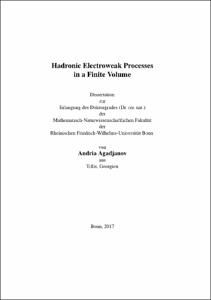Agadjanov, Andria: Hadronic Electroweak Processes in a Finite Volume. - Bonn, 2017. - Dissertation, Rheinische Friedrich-Wilhelms-Universität Bonn.
Online-Ausgabe in bonndoc: https://nbn-resolving.org/urn:nbn:de:hbz:5n-49071
Online-Ausgabe in bonndoc: https://nbn-resolving.org/urn:nbn:de:hbz:5n-49071
@phdthesis{handle:20.500.11811/7302,
urn: https://nbn-resolving.org/urn:nbn:de:hbz:5n-49071,
author = {{Andria Agadjanov}},
title = {Hadronic Electroweak Processes in a Finite Volume},
school = {Rheinische Friedrich-Wilhelms-Universität Bonn},
year = 2017,
month = nov,
note = {In the present thesis, we study a number of hadronic electroweak processes in a finite volume. Our work is motivated by the ongoing and future lattice simulations of the strong interaction theory called quantum chromodynamics. According to the available computational resources, the numerical calculations are necessarily performed on lattices with a finite spatial extension.
The first part of the thesis is based on the finite volume formalism which is a standard method to investigate the processes with the final state interactions, and in particular, the elastic hadron resonances, on the lattice. Throughout the work, we systematically apply the non-relativistic effective field theory. The great merit of this approach is that it encodes the low-energy dynamics directly in terms of the effective range expansion parameters. After a brief introduction into the subject in Chapter 1, we formulate a framework for the extraction of the $Delta Ngamma^*$ (Chapter 2) as well as the $Brightarrow K^*$ (Chapter 3) transition form factors from lattice data. Both processes are of substantial phenomenological interest, including the search for physics beyond the Standard Model. Moreover, we provide a proper field-theoretical definition of the resonance matrix elements, and advocate it in comparison to the one based on the infinitely narrow width approximation.
In the second part, which includes Chapter 4, we consider certain aspects of the doubly virtual nucleon Compton scattering. The main objective of the work is to answer the question whether there is, in the Regge language, a so-called fixed pole in the process. To answer this question, the unknown subtraction function, which enters one of the dispersion relations for the invariant amplitudes, has to be determined. The external field method provides a feasible approach to tackle this problem on the lattice. Considering the nucleon in a periodic magnetic field, we derive a simple relation for the ground state energy shift up to a second order in the field strength. The obtained result encodes the value of the subtraction function at nonzero photon virtuality. The knowledge of the latter is also important to constrain the two-photon exchange contribution to the Lamb shift in a muonic hydrogen.},
url = {https://hdl.handle.net/20.500.11811/7302}
}
urn: https://nbn-resolving.org/urn:nbn:de:hbz:5n-49071,
author = {{Andria Agadjanov}},
title = {Hadronic Electroweak Processes in a Finite Volume},
school = {Rheinische Friedrich-Wilhelms-Universität Bonn},
year = 2017,
month = nov,
note = {In the present thesis, we study a number of hadronic electroweak processes in a finite volume. Our work is motivated by the ongoing and future lattice simulations of the strong interaction theory called quantum chromodynamics. According to the available computational resources, the numerical calculations are necessarily performed on lattices with a finite spatial extension.
The first part of the thesis is based on the finite volume formalism which is a standard method to investigate the processes with the final state interactions, and in particular, the elastic hadron resonances, on the lattice. Throughout the work, we systematically apply the non-relativistic effective field theory. The great merit of this approach is that it encodes the low-energy dynamics directly in terms of the effective range expansion parameters. After a brief introduction into the subject in Chapter 1, we formulate a framework for the extraction of the $Delta Ngamma^*$ (Chapter 2) as well as the $Brightarrow K^*$ (Chapter 3) transition form factors from lattice data. Both processes are of substantial phenomenological interest, including the search for physics beyond the Standard Model. Moreover, we provide a proper field-theoretical definition of the resonance matrix elements, and advocate it in comparison to the one based on the infinitely narrow width approximation.
In the second part, which includes Chapter 4, we consider certain aspects of the doubly virtual nucleon Compton scattering. The main objective of the work is to answer the question whether there is, in the Regge language, a so-called fixed pole in the process. To answer this question, the unknown subtraction function, which enters one of the dispersion relations for the invariant amplitudes, has to be determined. The external field method provides a feasible approach to tackle this problem on the lattice. Considering the nucleon in a periodic magnetic field, we derive a simple relation for the ground state energy shift up to a second order in the field strength. The obtained result encodes the value of the subtraction function at nonzero photon virtuality. The knowledge of the latter is also important to constrain the two-photon exchange contribution to the Lamb shift in a muonic hydrogen.},
url = {https://hdl.handle.net/20.500.11811/7302}
}






